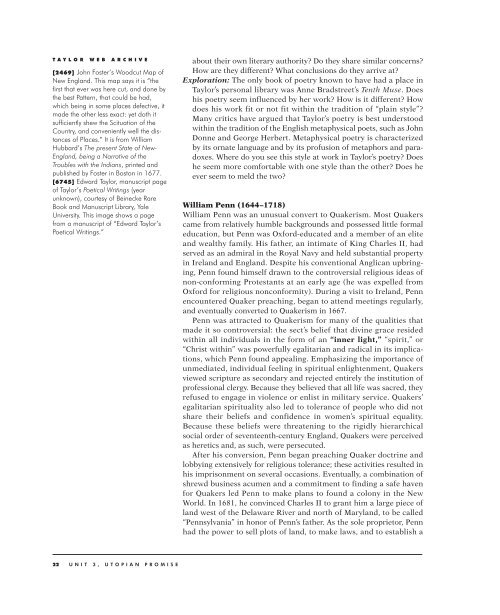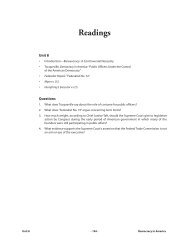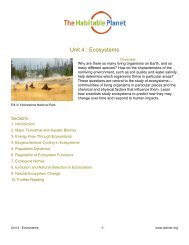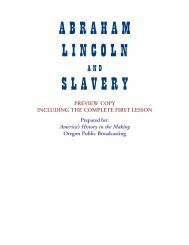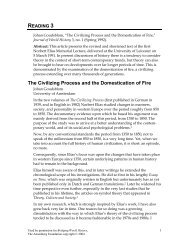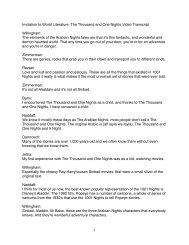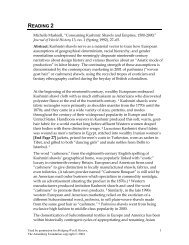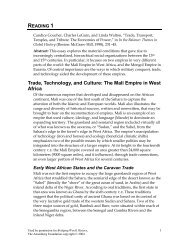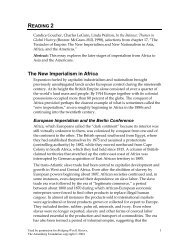UTOPIAN PROMISE - Annenberg Media
UTOPIAN PROMISE - Annenberg Media
UTOPIAN PROMISE - Annenberg Media
Create successful ePaper yourself
Turn your PDF publications into a flip-book with our unique Google optimized e-Paper software.
TAYLOR WEB ARCHIVE<br />
[2469] John Foster’s Woodcut Map of<br />
New England. This map says it is “the<br />
first that ever was here cut, and done by<br />
the best Pattern, that could be had,<br />
which being in some places defective, it<br />
made the other less exact: yet doth it<br />
sufficiently shew the Scituation of the<br />
Country, and conveniently well the distances<br />
of Places.” It is from William<br />
Hubbard’s The present State of New-<br />
England, being a Narrative of the<br />
Troubles with the Indians, printed and<br />
published by Foster in Boston in 1677.<br />
[6745] Edward Taylor, manuscript page<br />
of Taylor’s Poetical Writings (year<br />
unknown), courtesy of Beinecke Rare<br />
Book and Manuscript Library, Yale<br />
University. This image shows a page<br />
from a manuscript of “Edward Taylor’s<br />
Poetical Writings.”<br />
22 UNIT 3, <strong>UTOPIAN</strong> <strong>PROMISE</strong><br />
about their own literary authority? Do they share similar concerns?<br />
How are they different? What conclusions do they arrive at?<br />
Exploration: The only book of poetry known to have had a place in<br />
Taylor’s personal library was Anne Bradstreet’s Tenth Muse. Does<br />
his poetry seem influenced by her work? How is it different? How<br />
does his work fit or not fit within the tradition of “plain style”?<br />
Many critics have argued that Taylor’s poetry is best understood<br />
within the tradition of the English metaphysical poets, such as John<br />
Donne and George Herbert. Metaphysical poetry is characterized<br />
by its ornate language and by its profusion of metaphors and paradoxes.<br />
Where do you see this style at work in Taylor’s poetry? Does<br />
he seem more comfortable with one style than the other? Does he<br />
ever seem to meld the two?<br />
William Penn (1644–1718)<br />
William Penn was an unusual convert to Quakerism. Most Quakers<br />
came from relatively humble backgrounds and possessed little formal<br />
education, but Penn was Oxford-educated and a member of an elite<br />
and wealthy family. His father, an intimate of King Charles II, had<br />
served as an admiral in the Royal Navy and held substantial property<br />
in Ireland and England. Despite his conventional Anglican upbringing,<br />
Penn found himself drawn to the controversial religious ideas of<br />
non-conforming Protestants at an early age (he was expelled from<br />
Oxford for religious nonconformity). During a visit to Ireland, Penn<br />
encountered Quaker preaching, began to attend meetings regularly,<br />
and eventually converted to Quakerism in 1667.<br />
Penn was attracted to Quakerism for many of the qualities that<br />
made it so controversial: the sect’s belief that divine grace resided<br />
within all individuals in the form of an “inner light,” “spirit,” or<br />
“Christ within” was powerfully egalitarian and radical in its implications,<br />
which Penn found appealing. Emphasizing the importance of<br />
unmediated, individual feeling in spiritual enlightenment, Quakers<br />
viewed scripture as secondary and rejected entirely the institution of<br />
professional clergy. Because they believed that all life was sacred, they<br />
refused to engage in violence or enlist in military service. Quakers’<br />
egalitarian spirituality also led to tolerance of people who did not<br />
share their beliefs and confidence in women’s spiritual equality.<br />
Because these beliefs were threatening to the rigidly hierarchical<br />
social order of seventeenth-century England, Quakers were perceived<br />
as heretics and, as such, were persecuted.<br />
After his conversion, Penn began preaching Quaker doctrine and<br />
lobbying extensively for religious tolerance; these activities resulted in<br />
his imprisonment on several occasions. Eventually, a combination of<br />
shrewd business acumen and a commitment to finding a safe haven<br />
for Quakers led Penn to make plans to found a colony in the New<br />
World. In 1681, he convinced Charles II to grant him a large piece of<br />
land west of the Delaware River and north of Maryland, to be called<br />
“Pennsylvania” in honor of Penn’s father. As the sole proprietor, Penn<br />
had the power to sell plots of land, to make laws, and to establish a


